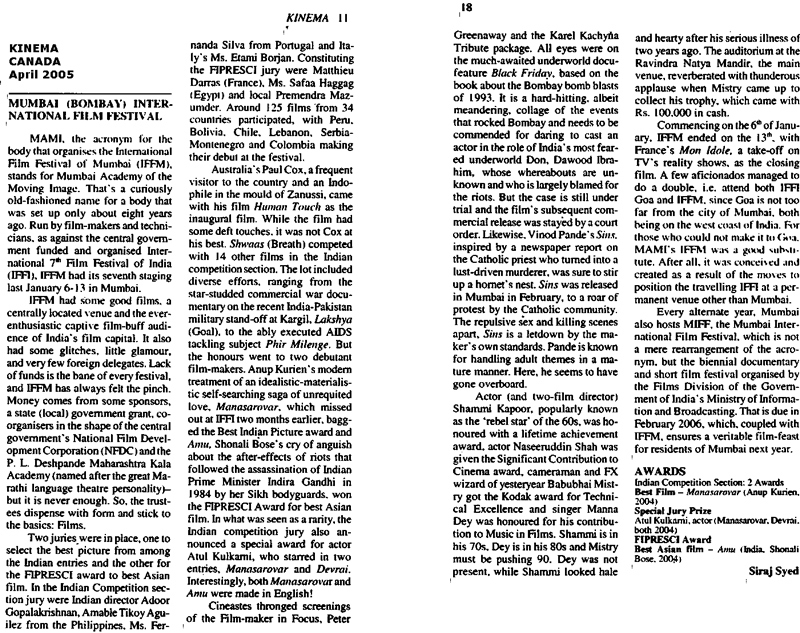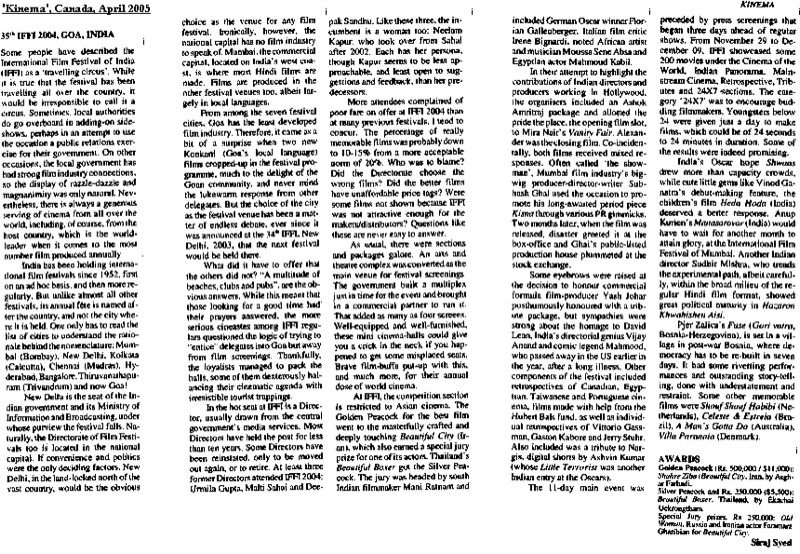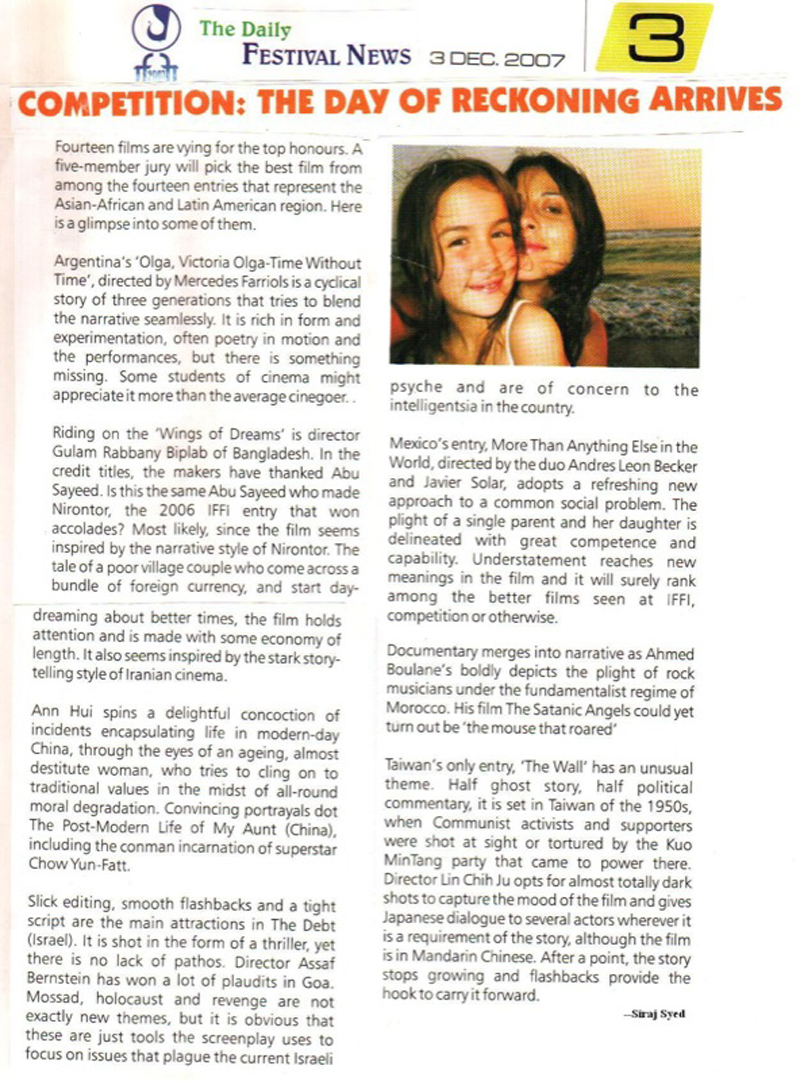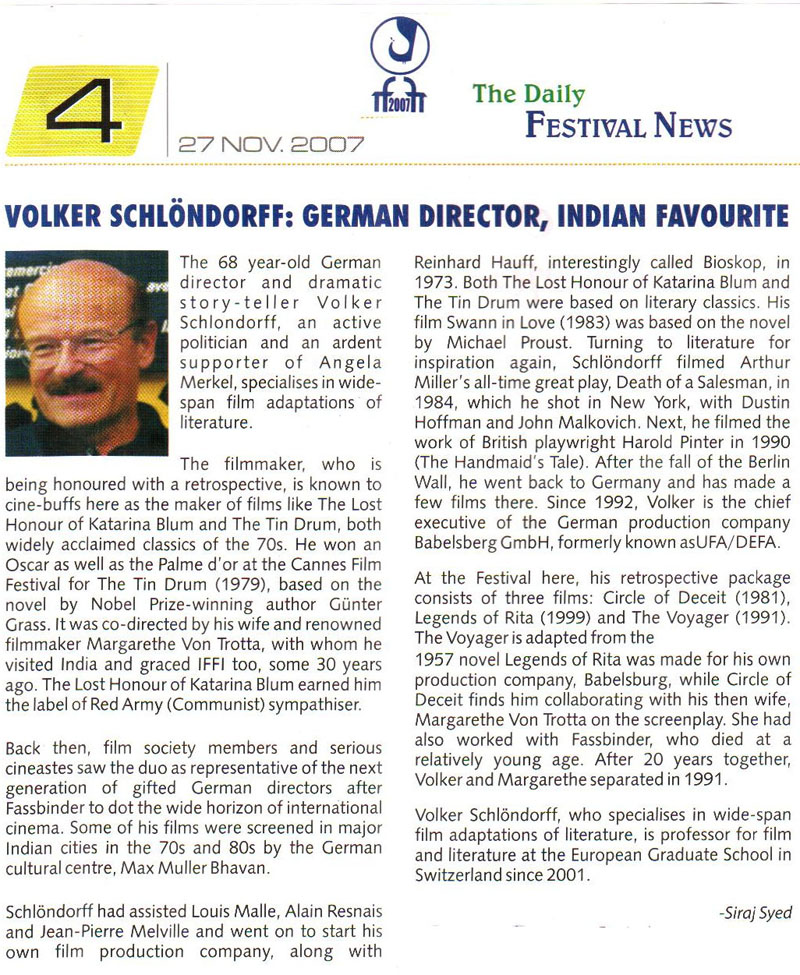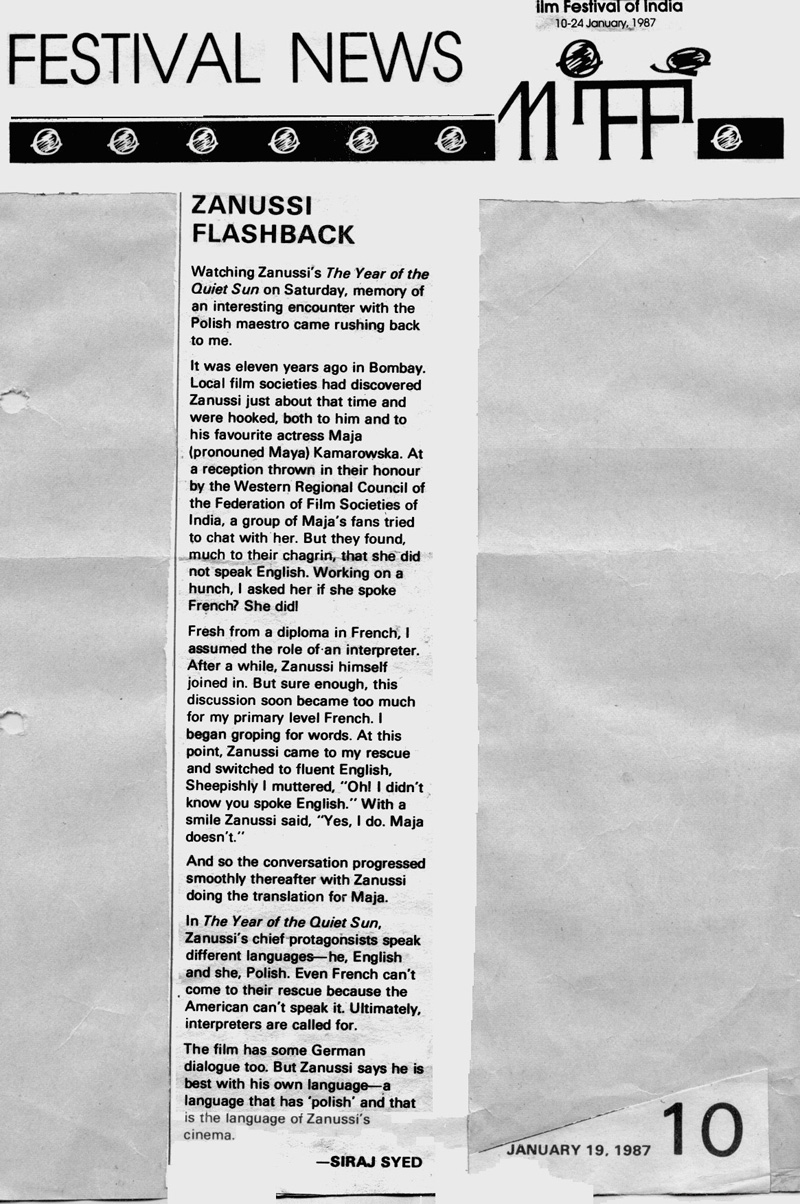|
|
||
|
Pro Tools
FILMFESTIVALS | 24/7 world wide coverageWelcome ! Enjoy the best of both worlds: Film & Festival News, exploring the best of the film festivals community. Launched in 1995, relentlessly connecting films to festivals, documenting and promoting festivals worldwide. Working on an upgrade soon. For collaboration, editorial contributions, or publicity, please send us an email here. User login |
Laila Majnu, Review: Crazy lovers in serene Kashmir
Laila Majnu, Review: Crazy lovers in serene Kashmir Transposed from ancient Arabia to modern Kashmir, the tale of doomed lovers Laila and Majnu is retold by brothers Imtiaz Ali and Sajid Ali. Setting it in scenic, serene, Kashmir was probably the only thing that they got right, for in almost all the other departments they have failed to score. Told at a pace that varies from the frenetic to the crawling, the film fails to strike a chord with the audience, a cardinal mistake that seals its fate as strongly as that of its protagonists. Laila (Laily, in its ancient script) means of the night/dark and Majnu (Majnoon, to be accurate) means a junoonee or crazed person. Majnu’s real name was Qais. Theirs is a love story that originated as poem in 11th Century Arabia, and was later was adapted by the Persian poet Nizami Ganjavi, who also wrote ‘Khosrow and Shirin’. It is the third of his five long narrative poems, Khamsa (the Quintet), khamsa meaning five. Qais and Laila fall in love with each other when they are young, but when they grow up, Layla’s father doesn't allow them to be together. Qais becomes obsessed with her, and the community gives him the epithet Majnun, the same epithet given to the semi-historical character Qais ibn al-Mulawwah of the Banu Amir tribe. Long before Nizami, the legend circulated in anecdotal forms in Arabic akhbar (published works/newspapers). The early anecdotes and oral reports about Majnun are documented in Kitab al-Aghani and Ibn Qutaybah's al-Shi'r wal-Shu'ara'. Many imitations have been contrived of Nizami's work, several of which are original literary works in their own right, including Amir Khusrow Dehlavi's ‘Majnun o Leyli’ (completed in 1299), and Jami's version, completed in 1484, which amounts to 3,860 couplets. Other notable re-workings are by Maktabi Shirazi, Hatefi (d. 1520), and Fazli (d.1556), which became popular in Ottoman Turkey and India. Sir William Jones published Hatefi's romance in Calcutta, in 1788. The popularity of the romance, following Nizami's version, is also evident from the references to it in lyrical poetry and mystical masnavis (epic poems). In India, it has been filmed many times. There were three versions made in British India. After the Shammi Kapoor-Nutan starrer in 1953, we had a Rishi Kapoor and Ranjeeta pairing in the 1976 outing, which had all round excellence and won an award for its music. Ten years down the line, K.C. Bokadia released the incomplete Love and God, which under production when its maker, the master called K. Asif (remember Mughal-e-Azam?) died. It starred an aging Nimmi and Sanjeev Kumar, who had also died before its release. The film sank without a trace. Inspirations were seen in many other films, for the ‘lovers against families’ theme was a favourite staple for decades, and it is with this background of history/mythology comes the 2018 release. In Bijnore village, Anupgarh, 11 kms from Sriganganagar, India, we have our own Laila Majnu story. According to this variation, the star-crossed lovers were from Sindh and came to this remote place, escaping from the clutches of Laila's parents and her brother, who were against the relationship of Laila-Majnu. But this area was part of large desert at that time, and Laila and Majnu could not go far due to difficult terrain. Finally Laila's parents followed them, and found them dead. Thus this place became a symbol of love, so newly-wed couples and people in love come here to seek blessings of Laila and Majnu for lasting love in their relationship. Every year, a fair is organised on14 June by the local Border Security Force (BSF) unit. That is so because the place is very close to the border with Pakistan, India’s neighbour, with whom India has fought wars, and the hostilities continue. Though it comes with so much baggage, in a sense, the film is original, professing no fore-knowledge about the ancient lore. Laila and Qais here are present-day lovers, pretending as if the events took place here and now. Sarwar Bhatt has purchased a plot of land from the Kashmir government that includes the Shalimar Hotel, owned by another local bigwig, Masood. This leads to a bitter feud. What worsens the enmity is that their children, Laila (Masood’s daughter) and Qais (Sarwar’s son) have fallen head over heels in love and want to get married. Sarwar comes begging for Laila’s hand, but is rebuked and humiliated by Masood. To add to his misery, Laila is married off to Masood’s adopted son. Sarwar dies of a heart-attack and England-returned Qais returns to London. Not too late afterwards, Qais returns to Kashmir and re-ignites the bond. Laila, who had earlier chided him for not being man enough to win her father over, now starts sympathising with him. Her marriage crumbles and she asks for divorce. But her husband is now a Member of the Legislative Assembly and a very powerful man. He will not give in easily. While waiting for Laila to be freed from her bondage, Qais goes crazy and wanders around like a madman, indulging in blasphemy and thievery. Laila holds herself responsible for his plight. As everybody knows, the end is tragic, a double whammy. Elder brother Imtiaz Ali (Jab We Met, Rockstar, Tamasha) co-produced and co-wrote this film for Jr. Ali, Sajid, whose only credential so far is co-writing the romantic comedy-drama Cocktail (2012) along with Imtiaz, makes his directorial debut. The early scenes bear the trade-mark Imtiaz style of grand yet earthy romances, with a dash of humour, and losing control over wayward hearts. Some of these scenes impress, as does the magnificence that is Kashmir. But soon enough, it starts falling apart. The premise of the feud between the two families is not justification enough for what they resort to. It is unclear whether Laila is a naïve nymph or is really, madly in love or is fooling herself, as well as, among others, her family and her sister Ambreen. Likewise Qais’s falling for Laila. Besides one shot of a childhood encounter, there is no real chemistry that ignites the screen for you to applaud and get swept away, like the two lovers themselves. Some girl-talk in the early scenes are interesting and funny, while the character of Laila’s husband almost slips into caricature, but for a strong performance. What begins as a good use of the Urban dictionary word What? is then beaten to death by numerous repetitions. Tripti Dimri as Laila made her debut in the comedy Poster Boys, but this film is a notch lower on her merits. Her flushing passion often rings false and gazing pointedly is not really acting. Avinash Tiwary (Yudh-TV, Suno Na-Ek Nanhi Awaaz, Tu Hai Mera Sunday) as Qais does not have conventional good looks, nor does he have classical features. He tries hard at lending life to some poorly directed scenes, and often succeeds. Nevertheless, there is only so much he can do. Benjamin Gilani as Sarwar Bhatt is a welcome return after a long time. The small role does not do him much justice. Parmeet Sethi as Masood fits the role, but his mannerisms and expressions are largely the same for most of the film. Mir Sarwar (Bajrangi Bhaijaan, Phantom, Dishoom, Daddy) as Laila’s husband makes most of a meaty, if given to impotent outbursts, characterisation. Shagufta Ali is impressive in a brief role as Laila’s aunt. Abrar Qazi as Zaid impresses. Others in the cast lend routine support: Sumit Kaul, Sahiba Bali, Vasundhara Kaul, Sujata Sehgal, Farhana Bhatt, R.J. Rafiq, Moomin Rafiq and Shahid Gulfam. There are as many as eight songs, composed by Niladri Kumar and Joi Barua, barring one. Some of them are indeed compositions that will get around. Background score by Hitesh Sonik adds ambience to the proceedings. Cinematographer Sayak Bhattacharya deserves special mention of some lovely visuals, aided, of course, by the natural heaven on earth that Kashmir is. Laila Majnu is neither crazy like its Majnu nor naïve like Laila. Either position would have worked better than this confused medley, with rapid-fire cutting. What could have been an epic tale of legendary love turns out to be a picture pots-card for Kashmir. As a result, it is likely to go the Love and God way, rather than the Laila Majnu (1976) way. Or, to take an example from the career of Imtiaz Ali, the When Harry Met Sejal way, rather than the Jab We Met way. Rating: ** Trailer: https://www.youtube.com/watch?v=Cv-6cAHanZ8 09.09.2018 | Siraj Syed's blog Cat. : Abrar Qazi Avinash Tiawary Benjamin Gilani Farhana Bhatt Hitesh Sonik Imtiaz Ali Ji Barua Mir Sarwar Moomin Rafiq Niladri Kumar Parmeet Sethi Qais R.J. Rafiq Sahiba Bali Sajid Ali Sayak Bhattacharya Shagufta Ali Shahid Gulfam Sujata Sehgal Sumit Kaul Tripti Dimri Vasundhara Kaul Independent FILM
|
LinksThe Bulletin Board > The Bulletin Board Blog Following News Interview with EFM (Berlin) Director
Interview with IFTA Chairman (AFM)
Interview with Cannes Marche du Film Director
Filmfestivals.com dailies live coverage from > Live from India
Useful links for the indies: > Big files transfer
+ SUBSCRIBE to the weekly Newsletter Deals+ Special offers and discounts from filmfestivals.com Selected fun offers
> Bonus Casino
User imagesAbout Siraj Syed Syed Siraj Syed Siraj (Siraj Associates) Siraj Syed is a film-critic since 1970 and a Former President of the Freelance Film Journalists' Combine of India.He is the India Correspondent of FilmFestivals.com and a member of FIPRESCI, the international Federation of Film Critics, Munich, GermanySiraj Syed has contributed over 1,015 articles on cinema, international film festivals, conventions, exhibitions, etc., most recently, at IFFI (Goa), MIFF (Mumbai), MFF/MAMI (Mumbai) and CommunicAsia (Singapore). He often edits film festival daily bulletins.He is also an actor and a dubbing artiste. Further, he has been teaching media, acting and dubbing at over 30 institutes in India and Singapore, since 1984.View my profile Send me a message The EditorUser contributions |



















